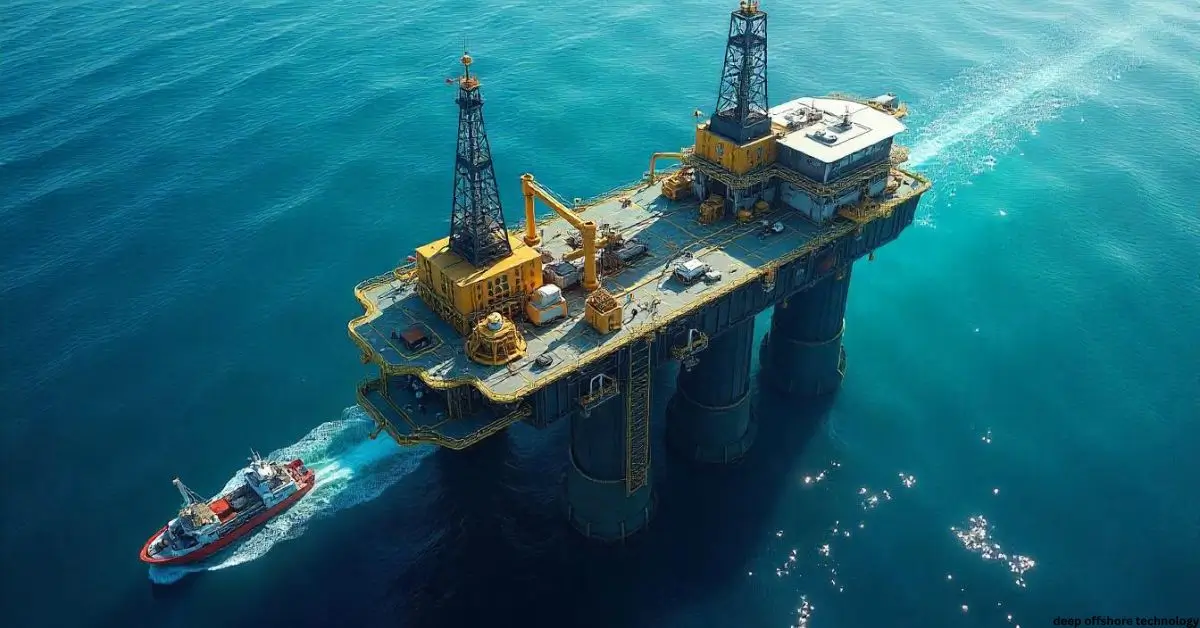TECHNOLOGY
Deep Offshore Technology: Revolutionizing Energy Exploration

Deep offshore technology has transformed the energy sector by making it possible to tap into resources located miles beneath the ocean’s surface. These sophisticated systems allow for exploration and production in challenging environments, helping meet global energy demand while ensuring safety, efficiency, and environmental responsibility.
A Brief History and Evolution of Deep Offshore Technology
Exploration of offshore resources began with basic shallow-water rigs. However, as onshore reserves declined, the industry ventured further into deeper waters. The 1970s marked the beginning of advanced offshore operations. Since then, innovations have led to today’s ability to operate in depths beyond 3,000 meters.
This journey required major advancements in engineering, underwater robotics, and materials science. From fixed platforms in shallow seas to floating and subsea systems that function in extreme depths, deep-sea energy recovery has become a technological marvel.
Core Technologies Behind Deep Offshore Technology Operations
Floating Production Units
Floating production storage and offloading vessels (FPSOs) are essential in modern offshore setups. These vessels extract, process, and store hydrocarbons and can operate independently without fixed infrastructure, offering great flexibility for remote fields.
Subsea Infrastructure
Subsea wellheads, manifolds, and pipelines form the backbone of underwater operations. These components sit on the seafloor and handle tasks like flow control, pressure management, and chemical injection. Advanced sensors and automation allow remote operation, reducing the need for personnel onsite.
Underwater Robotics
Remotely operated vehicles (ROVs) and autonomous underwater vehicles (AUVs) have become indispensable. ROVs handle maintenance and inspections, while AUVs map seafloor conditions and collect environmental data. These robotic systems reduce risk and improve precision.
Umbilicals and Control Lines
Subsea umbilicals connect underwater equipment to surface control units. They transmit power, control signals, and chemicals essential for smooth operation. These cables must withstand immense pressure and corrosion over long periods.
Benefits of Deep Offshore Technology
Modern marine energy infrastructure offers numerous advantages that extend beyond resource extraction. Here are the key benefits:
- Extended Access: Enables development of fields that were once unreachable.
- Higher Efficiency: Automation and real-time control reduce human error and downtime.
- Lower Environmental Risk: Real-time leak detection and containment systems prevent large-scale spills.
- Operational Flexibility: Modular and mobile units can be deployed and redeployed efficiently.
- Job Creation: Drives employment across engineering, logistics, and digital services.
Key Challenges in Deep Offshore Operations
While technology has advanced significantly, the offshore environment presents several persistent challenges:
Capital and Operational Costs
Deepwater projects are among the most expensive in the energy sector. Equipment, transportation, and risk mitigation measures require large financial investments, which can be impacted by fluctuating oil prices.
Technical Demands
Deep-sea installations must withstand high pressure, strong currents, and shifting geology. The complex integration of multiple systems increases the possibility of failure if not managed correctly.
Environmental and Regulatory Compliance
Strict environmental standards must be met, especially in sensitive marine ecosystems. Companies must follow international regulations, which often require advanced environmental impact assessments and continuous monitoring.
Logistics and Maintenance
Remote locations pose difficulties for transporting materials and conducting repairs. Weather disruptions and supply chain delays can halt operations or lead to safety concerns.
Comparing Technologies: Deep Offshore Technology vs Traditional Offshore Systems
| Feature | Deep Offshore Technology | Traditional Offshore Systems |
| Cost | High upfront and operational | Moderate initial investment |
| Efficiency | Highly efficient in deep zones | Less efficient in deep water |
| Ease of Use | Complex systems requiring expertise | Simpler operations |
| Scalability | Easily expandable | Limited scalability |
| Benefits | Access to untapped reserves | Restricted to shallow regions |
Real-World Applications
Countries like Brazil, Angola, and the United States have led in utilizing deep offshore capabilities. Brazil’s pre-salt formations, located beneath thick layers of salt and rock, require precision drilling and high-spec equipment.
In the Gulf of Mexico, floating platforms combined with subsea processing systems have increased output significantly while reducing environmental risk. These regions prove the commercial and technical viability of offshore energy extraction at great depths.
Innovations Shaping the Future
Subsea Factories
These are fully integrated units placed on the seafloor, handling separation, compression, and pumping processes. By minimizing the need for topside infrastructure, they reduce costs and environmental impact.
Digital Twins
Digital twin technology allows operators to simulate, monitor, and optimize systems using real-time data. These models help predict wear, manage maintenance, and avoid unexpected failures, all while improving uptime.
Smart Sensors and AI
Artificial intelligence enhances decision-making by analyzing huge volumes of operational data. Smart sensors detect changes in temperature, pressure, or vibration and trigger preventive actions before breakdowns occur.
Advanced Materials
Corrosion-resistant metals, thermal insulation, and lightweight composites are extending the lifespan of offshore equipment. These materials are vital to maintaining system integrity in hostile marine environments.
Hybrid Energy Systems
Modern installations increasingly integrate wind, wave, and solar technologies. Hybrid platforms reduce reliance on fossil fuels and help power remote systems without the need for diesel generators.
Environmental Considerations and Sustainability
Concerns about the marine ecosystem are growing. Oil and gas firms are now expected to conduct comprehensive impact assessments and implement rigorous mitigation strategies.
Reducing Ecological Footprint
Operators use low-toxicity drilling fluids, install noise-reduction devices, and monitor marine life. Some rigs are even decommissioned and turned into artificial reefs, promoting biodiversity.
Carbon Management
Many companies are investing in offshore carbon capture and storage (CCS). These projects involve injecting captured CO₂ into depleted reservoirs, turning former extraction sites into climate-friendly storage hubs.
Workforce Evolution and Training
As operations become more digital, the offshore workforce needs to evolve. Engineers must understand robotics, data analytics, and sustainability. Training programs now include virtual reality simulations, remote learning, and real-time collaboration tools.
Safety remains paramount. Crews are trained in emergency protocols, cybersecurity, and environmental stewardship to manage both technological and ethical challenges.
Global Standards and Reliability
Deep offshore systems operate under stringent global guidelines, ensuring the safety of personnel and marine environments. These standards require:
- Regular stress testing of components
- Advanced failure prediction models
- Transparent reporting on emissions and spills
- Redundant systems for power, communication, and safety
Reliability is critical in deep-sea operations, where the margin for error is minimal. Compliance with international norms boosts confidence among stakeholders and governments alike.
Economic Impact and Strategic Importance
The industry fuels national economies by creating high-value jobs, attracting foreign investment, and boosting energy independence. As shallow-water fields become depleted, the deep offshore sector is becoming more critical.
Governments increasingly view offshore energy capabilities as strategic assets. They offer insulation from supply shocks, stabilize prices, and enable countries to maintain self-reliance in energy sourcing.
Integration with Renewable Energy Goals
Interestingly, the technologies developed for deep offshore drilling are now being adapted for green energy initiatives. Floating wind turbines and marine energy converters rely on similar mooring, anchoring, and monitoring technologies.
Furthermore, the shift to hybrid platforms ensures smoother energy transitions by blending traditional fuels with renewables. This integration allows for cleaner operations without sacrificing energy security.
Conclusion
Deep offshore technology continues to redefine what’s possible in energy exploration. By enabling access to vast underwater reserves, improving safety, and aligning with sustainability goals, it supports the world’s growing and changing energy needs. From innovative robotics to environmentally responsible drilling, the future of offshore energy lies in balance—between progress and protection, between profit and planet.
FAQs
What is the primary purpose of deep offshore technology?
Its main goal is to explore and produce energy from ocean depths greater than 500 meters using advanced infrastructure like floating platforms and subsea systems.
How does this deep offshore technology benefit energy production?
It unlocks previously inaccessible reserves, increases operational safety, and allows efficient, continuous production even in remote and harsh conditions.
Are there risks associated with deep offshore projects?
Yes, risks include high costs, environmental hazards, and technical challenges. However, modern systems include safeguards like AI-based monitoring and emergency shutoffs.
Can deep offshore technology support renewable energy?
Absolutely. Techniques and platforms from offshore oil and gas operations are now used in offshore wind and tidal energy, making it versatile across the energy landscape.
Is deep offshore exploration harmful to marine ecosystems?
When managed poorly, it can be. However, modern operations follow strict environmental regulations, use eco-friendly materials, and conduct continuous biodiversity monitoring.
What qualifications are needed to work in this field?
Professionals typically need backgrounds in engineering, marine sciences, or data analytics. Specialized training in offshore safety and remote operations is also essential.
TECHNOLOGY
KZ43X9NNJM65-: What This Unique Identifier Could Mean

At first glance, kz43x9nnjm65- looks like a random jumble of letters and numbers—but in the digital world, such strings are rarely accidental. Alphanumeric codes like this one are commonly used as unique identifiers in software, databases, tracking systems, or security protocols. While kz43x9nnjm65- doesn’t correspond to any widely known public standard, it likely serves a specific technical purpose behind the scenes. This article explores what this type of code could mean, where you might encounter it, and how to respond if it appears unexpectedly on your device or in your workflow.
Importantly, there’s no evidence that kz43x9nnjm65- is malicious on its own—but understanding its context is key to using it safely and effectively.
Common Uses of Alphanumeric Identifiers Like KZ43X9NNJM65-
In computing, random-looking strings such as kz43x9nnjm65- are often generated automatically to label or track something unique. For example, they might act as session IDs for website logins, transaction references in e-commerce, or file names in cloud storage. The mix of lowercase letters, numbers, and sometimes symbols helps ensure each ID is distinct and hard to guess—boosting security and organization.
These identifiers are typically created by algorithms using cryptographic randomness or timestamp-based hashing. The trailing hyphen in kz43x9nnjm65- could be a formatting convention, a placeholder, or even a truncated character from a longer string. It’s not unusual in log files, API responses, or debugging outputs.
Typical Scenarios Where You Might See KZ43X9NNJM65-
- Web Session Tokens: Temporary IDs assigned when you log into a service
- Error Logs: Unique tags that help developers trace specific system failures
- Download Filenames: Auto-generated names for temporary or backup files
- API Request IDs: Used to track individual calls between software systems
- Database Keys: Internal references for records that aren’t meant for user display
Is KZ43X9NNJM65- Safe? What You Should Know
On its own, kz43x9nnjm65- is just data—it has no inherent risk. However, if you see it in an unexpected place (like a pop-up, email subject line, or strange filename), it’s wise to consider the context. For instance, if a file named kz43x9nnjm65-.exe appears in your Downloads folder, that could be suspicious, as legitimate software rarely uses such random names.
Conversely, if you’re a developer and this string appears in your application logs, it’s likely a normal part of system operation. Always check the source: Was it generated by a trusted app? Did you initiate the action that produced it? When in doubt, avoid clicking or executing anything tied to unfamiliar identifiers.
Why Developers Use Strings Like KZ43X9NNJM65-
From a technical standpoint, strings like kz43x9nnjm65- offer several advantages. They’re compact, easy for machines to process, and statistically unique—meaning the chance of duplication is extremely low. This makes them ideal for labeling millions of transactions, users, or events without confusion.
They also enhance privacy. Instead of using your email or name in logs, a system might assign you kz43x9nnjm65- as a pseudonym. This way, data can be analyzed without exposing personal information. Many privacy-focused platforms use this technique to comply with regulations like GDPR or CCPA.
What to Do If You Encounter KZ43X9NNJM65- Unexpectedly
If kz43x9nnjm65- shows up in a place that feels odd—like a text message from an unknown number or a strange entry in your task manager—take a cautious approach. First, avoid interacting with it directly. Next, run a quick system scan using trusted antivirus software. You can also search online to see if others have reported similar strings in phishing or malware campaigns, though most random IDs won’t yield public results.
For non-technical users, the safest rule is: If you didn’t create it or request it, treat it with caution. Legitimate services usually use readable names or clear labels—not obscure codes—when communicating with customers.
The Bigger Picture: Digital Literacy in an Automated World
As software becomes more automated, users will increasingly encounter machine-generated strings like kz43x9nnjm65-. Understanding their purpose reduces fear and helps people distinguish between normal system behavior and potential threats. Digital literacy isn’t just about passwords and privacy settings—it’s also about recognizing the “language” of computers and knowing when to investigate further.
In most cases, these identifiers are harmless background noise. But staying informed ensures you remain in control of your digital experience.
Final Thoughts
While kz43x9nnjm65- may seem cryptic, it’s almost certainly a routine part of how modern software operates. Whether it’s tracking your session, labeling a file, or debugging an app, such codes keep digital systems organized and secure. By learning to interpret them in context—and staying alert to red flags—you can navigate the online world with greater confidence and safety.
Frequently Asked Questions (FAQs)
1. Can I use kz43x9nnjm65- as a password?
It’s not recommended—while it looks random, it may already exist in public logs or databases, making it less secure.
2. Does kz43x9nnjm65- contain personal data?
No, it’s a reference ID; any link to personal info exists only in the system that generated it, not in the string itself.
3. Why does it end with a hyphen?
The hyphen may be a separator, a formatting artifact, or part of a base64-like encoding scheme—often harmless.
4. Is this string used in any known software?
There’s no public documentation linking it to major software, suggesting it’s either internal, temporary, or randomly generated.
5. Should I delete files named kz43x9nnjm65-?
Only if you don’t recognize their source; if they’re from a trusted app (like a browser or cloud service), they may be safe temporary files.
TECHNOLOGY
Who Is markyystreams? Exploring the Digital Creator’s Unique Online Presence
TECHNOLOGY
cflop-y44551/300: What This Unique Identifier Means Online
-

 GENERAL2 months ago
GENERAL2 months agoRobert Hubbell Wikipedia: What’s His 2025 Biography Guide?
-

 EDUCATION5 months ago
EDUCATION5 months agoJay Kuo Substack: Unpacking the Voice of Legal Insight
-

 GENERAL5 months ago
GENERAL5 months agoDream Cake: A Decadent Delight Worth Savoring
-

 EDUCATION5 months ago
EDUCATION5 months agoEconomic Blackout Results: The Financial Domino Effect
-

 GENERAL5 months ago
GENERAL5 months agoChris Hedges Substack: A Voice of Dissent in the Digital Age
-

 TECHNOLOGY5 months ago
TECHNOLOGY5 months agoHow to Cancel Substack Subscription
-

 GENERAL5 months ago
GENERAL5 months agoMax Azzarello Substack: Inside the Mind of a Radical Truth-Seeker
-

 ENTERTAINMENT5 months ago
ENTERTAINMENT5 months agoTyler the Creator Dad Truth


